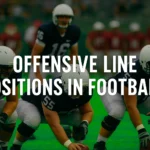Football is the ultimate team sport where every player on the field has a specific job to do. When you watch a football game, you see 11 players on the field for each team. Each of these players has different positions that are very important for the team’s success. Today, we will learn about some of the most important american football positions – the defensive line positions that form the first line of defense against the other team.
The defensive line positions in football is made up of the biggest and strongest players on the defense. These players line up directly across from the offensive line at the start of each play. Their main job is to stop the team that has the football from moving forward and to try to tackle the quarterback. To know these positions explained will help you enjoy watching football much more.
The Defensive Position Players and Defensive Line Positions in Football
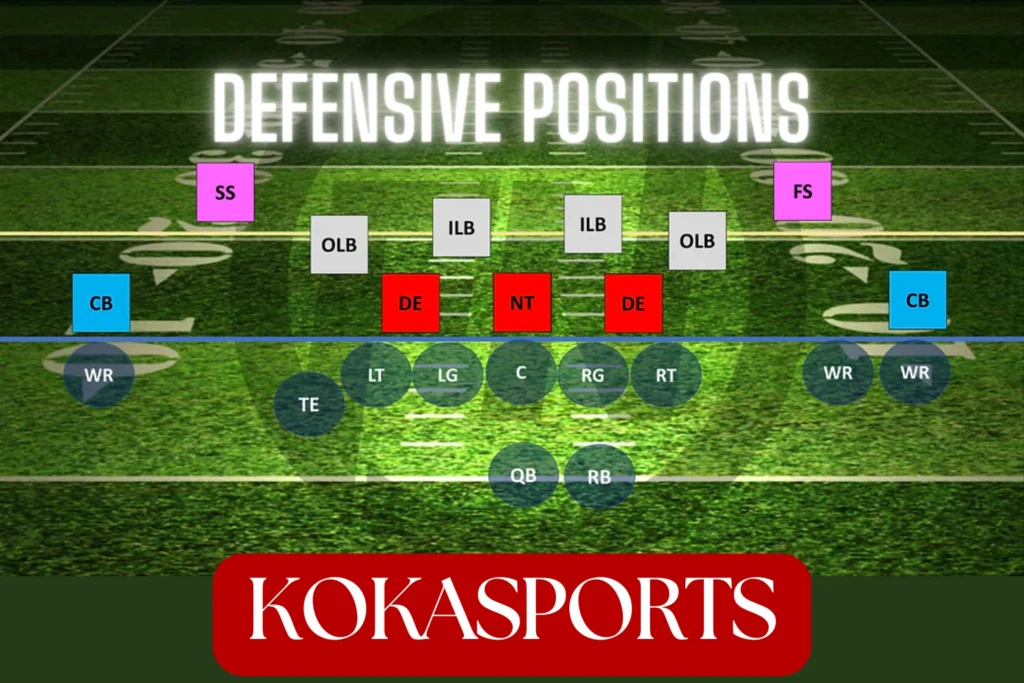
The defensive line positions in football are some of the most exciting positions in american football. These defensive position players are like the walls of a castle – they protect everything behind them. When the offense tries to run the ball or throw it, the defensive line is the first group of players they must get past.
In american football, the defensive line usually has three or four players. These players are called defensive linemen, and they are some of the biggest and strongest players on the football field. Each defensive lineman has a specific job based on where they line up on the field. Some line up on the outside edges, while others play in the middle of the defensive line.
What makes these positions so important? The defensive line positions are crucial because they are the closest players to the line of scrimmage when the play starts. The line of scrimmage is the imaginary line where the football sits before each play begins. Since these players line up right at this line, they are the first to make contact with the offensive players trying to move the ball forward.
Let me explain the main types of defensive line positions in football. There are usually two defensive ends who line up on the outside edges and one or two defensive tackles who play in the middle. In some formations, teams use a nose tackle instead of two defensive tackles. Each of these positions has different jobs, but they all work together as a team to stop the offense.
The coordination between defensive linemen is essential for success. When one player rushes the quarterback, the others must maintain their positions to prevent the quarterback from escaping. This teamwork is what makes the defensive line so effective at controlling the line of scrimmage and dictating the flow of the game.
Read Also: Offensive Line Positions in Football: Complete Guide to All Five Critical Positions (2025)
Introduction to Positions in Football: The Defensive Line
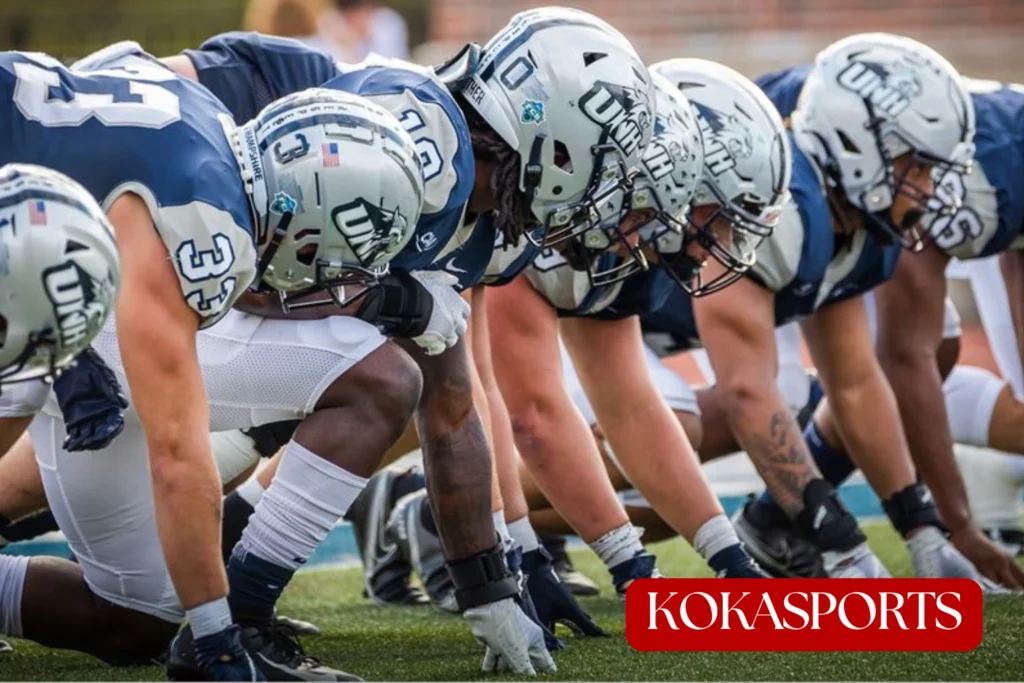
Before we learn about each specific defensive position, it’s important to understand how all the positions in football work together. Football teams have three main groups: offense (the team with the ball), defense (the team trying to stop them), and special teams positions (used for kicks and punts).
The defensive team has 11 players on the field, just like the offense. These 11 players are split into different groups based on where they line up and what their jobs are. The defensive line is just one part of the defense, but it’s a very important part because they are the line of defense that the offense must face first.
How the defensive line fits into the bigger picture:
- The defensive line plays at the line of scrimmage
- Linebackers play behind the defensive line and help with both run and pass plays
- Defensive backs (cornerbacks and safeties) line up further back and mainly cover receivers
- All these groups work together to stop the offensive team
The defensive line positions are different from offensive positions in many ways. While offensive players try to move the ball forward and score points, defensive players try to stop them. The offensive line tries to protect their quarterback and create holes for their running backs, while the defensive line tries to tackle the quarterback and stop the running backs from getting through.
These positions explained helps us see why football is such an exciting sport. Every player on the field has a specific job, and when all 11 players do their jobs well, the defense can stop even the best offensive teams from scoring.
The Four Core Defensive Line Positions in Football
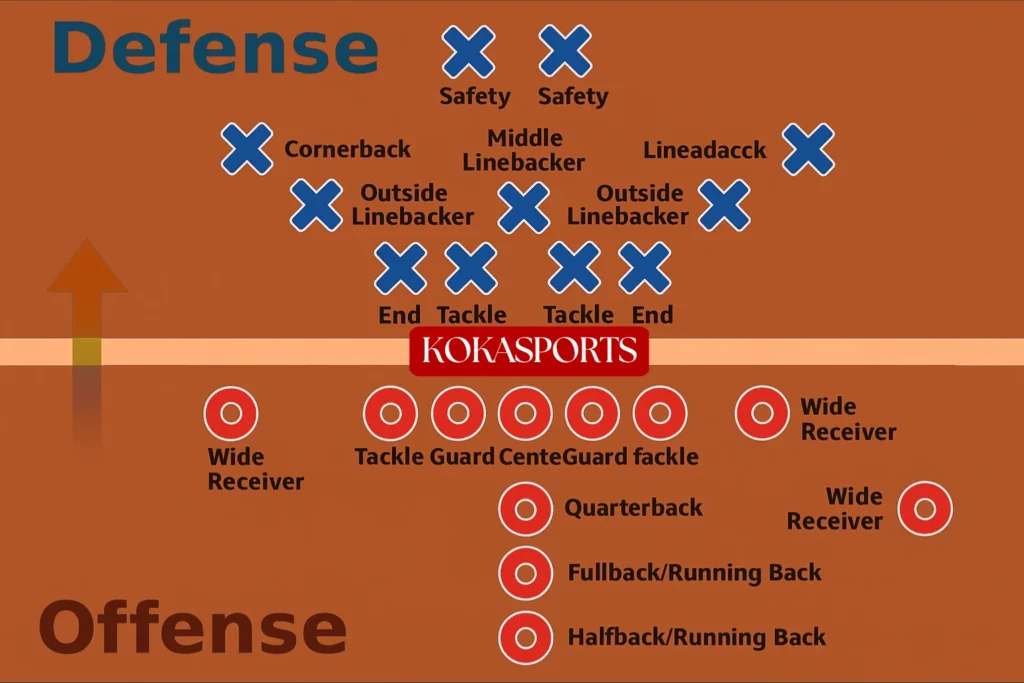
Now let’s learn about each specific defensive line position. These are the positions in american football that make up the heart of every defense. Each position has its own special job and requires different skills from the players who play there.
Defensive End Position: The Edge Rushers in Positions in Football
The defensive end is one of the most exciting positions in american football. Two defensive ends usually line up on the outside edges of the defensive line, one on each side. These players are like the bookends that hold everything together. They line up outside of the defensive tackles and are responsible for the end of the defensive line.
What does a defensive end do? A defensive end has many important jobs during each play. Their main job is to rush around the outside of the offensive line to try to tackle the quarterback. This is called a pass rush. When the offense tries to throw the ball, the defensive end tries to get to the quarterback before he can throw it.
The defensive end also has to stop running plays that come to their side of the field. When a running back tries to run outside of the defensive line, the defensive end must be there to tackle him or force him back inside where other defenders can help. This is called “setting the edge” because they control the outside edge of the defense.
Key skills for defensive ends:
- Speed – They need to be fast enough to chase down quarterbacks and running backs
- Strength – They must be strong enough to fight through offensive lineman who try to block them
- Agility – They need to be able to change direction quickly when chasing the ball
- Endurance – They must keep rushing the quarterback play after play
Defensive ends are usually taller and faster than other defensive linemen. They typically weigh between 250-280 pounds and are around 6’3″ to 6’6″ tall. This size helps them see over the offensive line and gives them long arms to bat down passes or tackle quarterbacks.
Modern defensive ends must also possess excellent hand-eye coordination to bat down passes at the line of scrimmage. When they cannot reach the quarterback in time, swatting down passes becomes their secondary objective. This skill requires precise timing and excellent reflexes, as the defensive end must react quickly to the quarterback’s throwing motion.
Defensive Tackle Position: Interior Dominance in Defensive Positions in Football
The defensive tackle position is played in the middle of the defensive line. These players are usually the biggest and strongest on the entire defense. Two defensive tackles typically line up between the two defensive ends, creating a wall of players across the middle of the offensive line.
The defensive tackle has one of the hardest jobs on the football field. They must fight against offensive lineman who are trying to push them out of the way so running backs can run through the middle. These tackle battles happen on almost every single play, making it one of the most physical positions in the sport.
When teams throw the ball, the defensive tackle rushes up the middle toward the quarterback. This is called interior pass rush, and it’s very effective because quarterbacks have a hard time seeing defensive players coming from right in front of them. A good defensive tackle can make it very difficult for quarterbacks to step forward in the pocket.
What makes a great tackle:
| Skill | Why It’s Important |
|---|---|
| Size and Strength | Must be big enough to take on multiple offensive lineman |
| Low Center of Gravity | Helps them stay balanced when being pushed |
| Quick First Step | Gets them moving fast when the ball is snapped |
| Hand Technique | Helps them fight off blocks from offensive lineman |
Defensive tackles are usually the heaviest players on the defense, often weighing 290-320 pounds. They need this weight to anchor the middle of the defensive line and prevent running backs from breaking through for big gains. Even though they are big, they still need to be athletic enough to chase down plays that go to other parts of the field.
The technique required to play defensive tackle effectively is quite sophisticated. Players must master the art of using leverage to their advantage, keeping their center of gravity low while maintaining the ability to shed blocks quickly. They must also develop exceptional hand strength and technique to disengage from offensive linemen who are trying to control them.
Nose Tackle: The Anchor of the Defensive Line
The nose tackle is a special type of defensive player used in certain defensive formations. Instead of having two defensive tackles, some teams use just one nose tackle who lines up directly in front of the center on the offensive line. This player sits right in the center of the defensive line.
The nose tackle is a defensive player who has one main job: control the middle of the offensive line. They line up directly over the center and must take on blocks from multiple offensive lineman. Often, both the center and one of the guards will try to block the nose tackle at the same time.
This position requires the biggest and strongest players in all of football. Nose tackle players often weigh 320-350 pounds or more. They need this size because they frequently face double-team blocks where two offensive lineman try to move them out of the way.
Why teams use a nose tackle:
- Stops running plays up the middle
- Forces the offense to use two players to block one defender
- Creates opportunities for other defensive players to make tackles
- Controls the center of the field on running plays
The nose tackle doesn’t usually rush the quarterback like other defensive linemen. Instead, their job is to stay in place and plug up the middle so running backs can’t run straight ahead for easy yards. They are like a big tree trunk that the offense has to run around.
Outside Linebacker/Edge Rusher Hybrid Defensive Position
In modern football, teams sometimes use special players called outside linebackers who play at the line of scrimmage like defensive linemen. These players are a mix between linebackers and defensive ends. They line up behind the traditional defensive line but very close to the line of scrimmage.
These hybrid players give defenses more flexibility. Sometimes they line up directly at the line like a defensive end, and sometimes they stand behind the defensive line like a linebacker. This makes it hard for the offense to know what they’re going to do.
How these players are different:
- They are usually smaller and faster than traditional defensive linemen
- They can cover receivers in pass play situations
- They can rush the quarterback from different angles
- They can drop back and help cover the middle of the field
These hybrid defensive position players are becoming more common in today’s NFL. Teams like having players who can do multiple jobs because it keeps the offense guessing about what the defense will do next.
Defensive Line Techniques and Fundamentals for American Football Positions
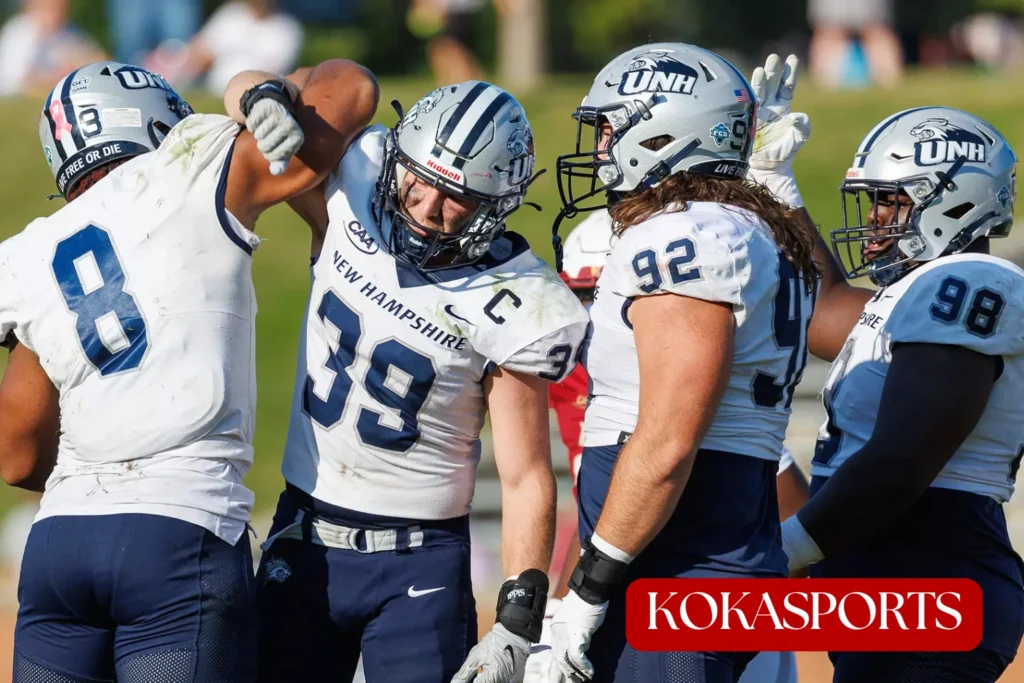
Learning the basic techniques that defensive line players use helps us understand why these positions in american football are so important. Every defensive lineman must master certain skills to be successful at their position.
Essential Pass Rush Techniques for Defensive Positions in Football
When the offense throws the ball, defensive line players use special techniques to try to reach the quarterback. These techniques are called pass rush moves, and each player on the field must practice them constantly.
The Speed Rush is the most basic pass rush move. The defensive player tries to run around the outside of the offensive line as fast as possible. This works best for defensive ends who line up on the edges because they have more room to run around their blocker.
The Power Rush is when a defensive lineman uses pure strength to push the offensive lineman backward toward the quarterback. This technique works well for bigger defensive tackles who have the size and strength to overpower their opponents.
The Spin Move is a fancy technique where the defensive player starts to rush one way, then spins around to go the other direction. This can confuse the offensive lineman and create an opening to reach the quarterback.
Key points for good pass rushing:
- Get a quick first step when the ball is snapped
- Use your hands to fight off the offensive lineman
- Keep your eyes on the quarterback at all times
- Don’t give up on the play even if you get blocked at first
Run Defense Techniques for Defensive Line Players
Stopping running plays is just as important as rushing the quarterback. When the offense hands the ball to a running back, every defensive lineman must do their job to prevent big gains.
Gap Control is the most important concept in run defense. Each defensive player is responsible for a specific area called a “gap.” If every player controls their gap, there will be no room for the running back to run through.
Shedding Blocks means getting away from offensive lineman who are trying to block you. Defensive players must use their hands and body position to get free from blocks so they can make the tackle.
The defensive line must work together as a team to stop running plays. If one player gets out of position or misses their assignment, the running back might break through for a big gain.
Defensive Line Positions in Different American Football Schemes
Different teams use different defensive formations, and this changes how the defensive positions in football are used. Let’s look at the two most common defensive schemes and how they use the defensive line.
4-3 Defense and Defensive Positions in Football Alignment
The 4-3 defense is called that because it uses four defensive linemen and three linebackers. This formation has two defensive ends and two defensive tackles on the defensive line. The four defensive linemen and three linebackers work together to stop the offense.
In this formation, each defensive lineman usually has a specific gap to control. The defensive ends control the outside gaps, while the defensive tackles control the inside gaps. The three linebackers play behind the defensive line and help with both run and pass defense.
Advantages of the 4-3 defense:
- Having four pass rushers can put lots of pressure on the quarterback
- Good against teams that like to throw the ball frequently
- The defensive line can block defensive players from getting to the linebackers
- Works well when you have four good defensive linemen
3-4 Defense Positioning in Positions in American Football
The 3-4 defense uses three defensive linemen and four linebackers. The defense has three defensive linemen consisting of two defensive ends and one nose tackle in the middle. The three defensive linemen and four linebackers give this formation a different look.
In the 3-4 defense, the defensive linemen’s main job is to control offensive lineman and free up the linebackers to make plays. The nose tackle especially must take on double teams so the linebackers can run free.
How the 3-4 is different:
- Three defensive linemen means bigger players who can take on multiple blockers
- Four linebackers give more speed and coverage ability
- Outside linebackers often rush the quarterback like defensive ends
- Better against teams that run the ball a lot
Skills and Attributes Required for Each Defensive Position
Each defensive line position requires different skills and physical abilities. Understanding what makes a good defensive lineman helps us appreciate how hard these players work to master their positions.
Physical Requirements by Defensive Line Positions Explained
Size and Strength Requirements:
| Position | Height | Weight | Key Attributes |
|---|---|---|---|
| Defensive End | 6’3″ – 6’6″ | 250-280 lbs | Speed, Length, Agility |
| Defensive Tackle | 6’1″ – 6’4″ | 290-320 lbs | Strength, Power, Size |
| Nose Tackle | 6’0″ – 6’3″ | 320-350 lbs | Mass, Anchor Strength |
Each position needs different physical tools to be successful. Defensive ends need to be fast enough to chase down quarterbacks who try to run away from them. Defensive tackles need to be strong enough to fight through double-team blocks. Nose tackle players need to be big enough to take on multiple offensive lineman at once.
Speed and Athleticism: Even though defensive linemen are some of the biggest players on the field, they still need to be athletic. A defensive end might need to chase a running back all the way across the field. A defensive tackle might need to drop back and cover a tight end in the passing game.
Mental Skills and Football IQ for American Football Positions
Being smart is just as important as being strong and fast. Defensive lineman must understand what the offense is trying to do before the play even starts. They study film of their opponents and learn to recognize different offensive formations and plays.
Pre-Snap Recognition means looking at how the offense lines up and trying to guess what play they’re going to run. If a defensive player can figure out whether it’s going to be a run or pass play, they can react faster when the ball is snapped.
Communication is very important for the defensive line. Players must talk to each other before each play to make sure everyone knows their assignment. The center of the defensive line often acts like the quarterback of the defense, making sure everyone is lined up correctly.
Famous Players and Success Stories by Defensive Position
Learning about great players who played these positions helps us understand what makes them so special. These players show us what’s possible when someone masters their defensive position.
Legendary Defensive End Players in American Football History
Reggie White is often called the greatest defensive end of all time. He was known as the “Minister of Defense” and had incredible strength and speed. White could rush the passer and stop the run equally well, making him a complete defensive end.
Bruce Smith holds the NFL record for career sacks with 200. He played his entire career as a defensive end and showed that consistency and longevity are just as important as having great seasons.
Modern players like J.J. Watt have shown how defensive end players can impact the game in multiple ways. Watt has intercepted passes, recovered fumbles, and even caught touchdown passes on offense.
TOP Greatest Defensive Linemen in NFL History
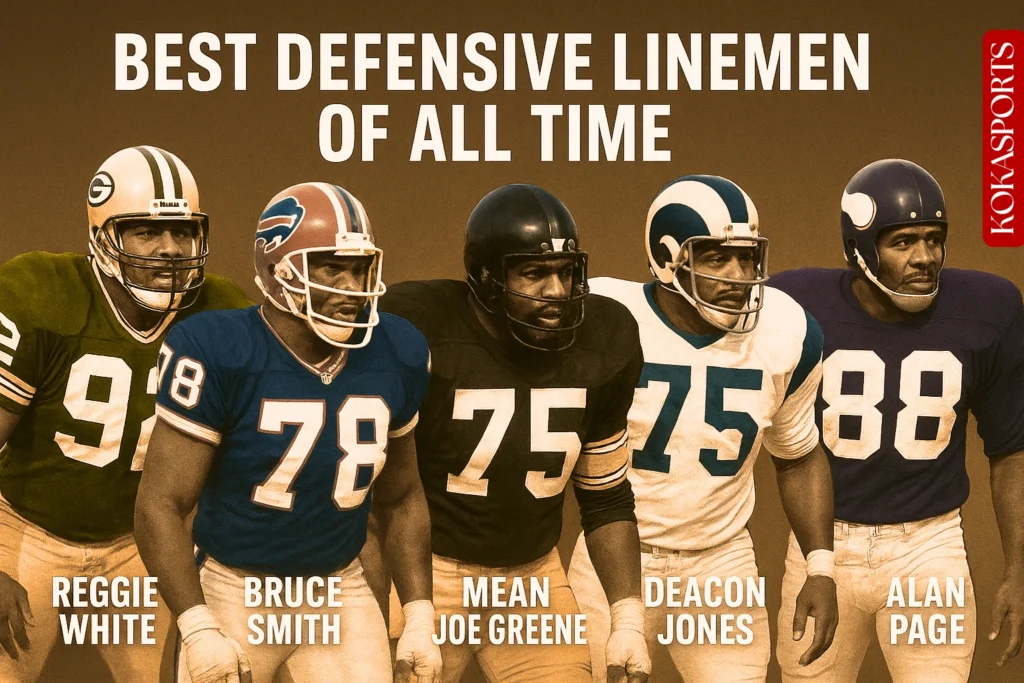
Reggie White (DE/DT, 1985–2000)
- The Minister of Defense”
- 13-time Pro Bowler, 2-time NFL Defensive Player of the Year
- 198 career sacks (2nd all-time)
- Feared for his power moves, especially the “hump move.”
- Super Bowl XXXI champion (Packers).
Bruce Smith (DE, 1985–2003)
- NFL’s all-time sack leader with 200
- 11-time Pro Bowler, 2-time NFL Defensive Player of the Year
- Anchor of the Buffalo Bills’ defense during four straight Super Bowls.
Mean Joe Greene (DT, 1969–1981)
- Heart of the legendary Steel Curtain Pittsburgh Steelers defense
- 10-time Pro Bowler, 2-time Defensive Player of the Year
- 4-time Super Bowl champion
- Set the standard for dominant defensive tackles.
Deacon Jones (DE, 1961–1974)
- Credited with coining the term “sack”
- 8-time Pro Bowler, 2-time Defensive Player of the Year
- Nicknamed the “Secretary of Defense”
- Famous for his unstoppable pass rush and head-slap move.
Alan Page (DT, 1967–1981)
- Key member of the Minnesota Vikings’ Purple People Eaters defense
- 9-time Pro Bowler, NFL MVP in 1971 (first defensive player to win MVP)
Conclusion
The defensive line is the backbone of every football defense. These brave players – defensive ends, defensive tackles, nose tackles, and hybrid edge rushers – work together to stop the offense from moving the ball down the field.
Each position has its own special job, but they all share the same goal: protect their team’s end zone. Whether they’re rushing the quarterback, stopping running backs, or controlling gaps in the line, these players make football exciting to watch.
These positions helps you enjoy football games even more. The next time you watch a game, pay attention to the big guys up front – they’re doing some of the hardest and most important work on the field!
FAQs
What are the positions on the defensive line?
Defensive end, defensive tackle, and nose tackle are the main positions on the defensive line.
What is a defensive line in football?
The defensive line is the group of players who line up directly across from the offensive line to stop running plays and rush the quarterback.
How many D-linemen are there?
There are typically 3-4 defensive linemen on the field, depending on the defensive formation used.
Is a linebacker O-line or D-line?
A linebacker is neither O-line nor D-line – they are a separate defensive position that plays behind the defensive line.


